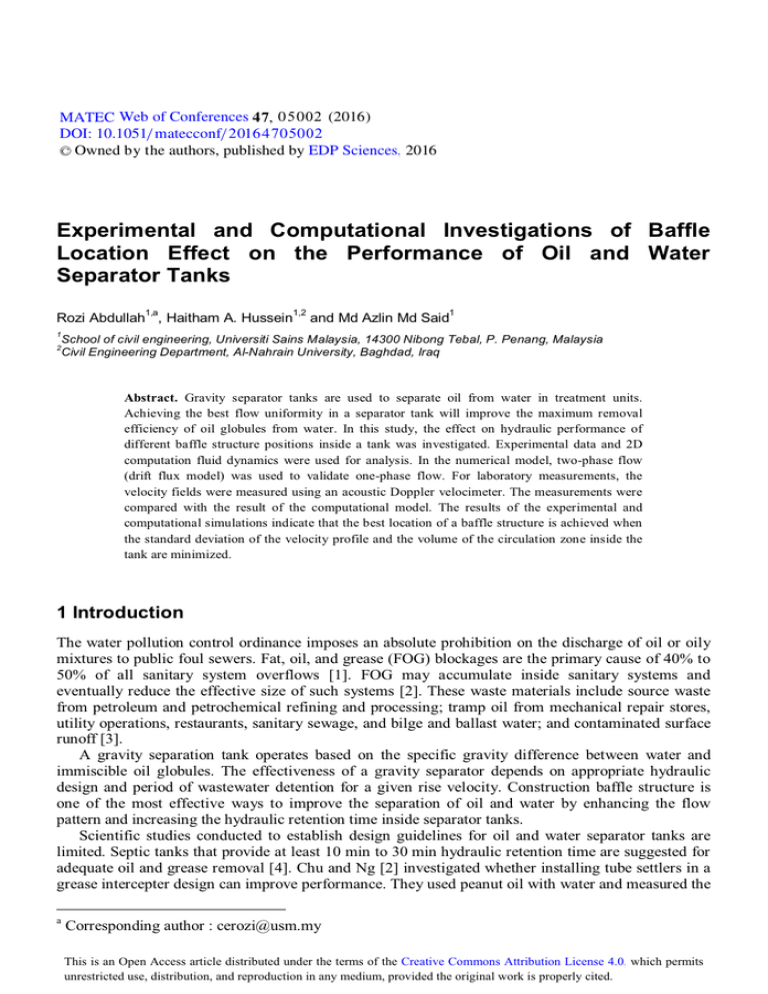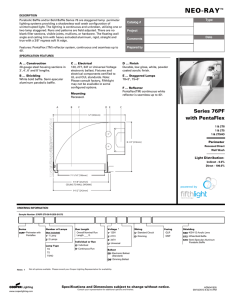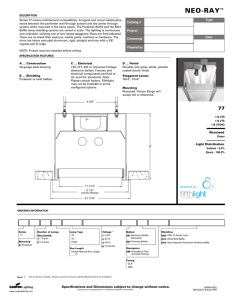Document 14212231
advertisement

MATEC Web of Conferences 4 7, 0 5 0 02 (2016 )
DOI: 10.1051/ m atecconf/ 2016 47 0 5 0 02
C Owned by the authors, published by EDP Sciences, 2016
Experimental and Computational Investigations of Baffle
Location Effect on the Performance of Oil and Water
Separator Tanks
1,a
1,2
Rozi Abdullah , Haitham A. Hussein
1
2
1
and Md Azlin Md Said
School of civil engineering, Universiti Sains Malaysia, 14300 Nibong Tebal, P. Penang, Malaysia
Civil Engineering Department, Al-Nahrain University, Baghdad, Iraq
Abstract. Gravity separator tanks are used to separate oil from water in treatment units.
Achieving the best flow uniformity in a separator tank will improve the maximum removal
efficiency of oil globules from water. In this study, the effect on hydraulic performance of
different baffle structure positions inside a tank was investigated. Experimental data and 2D
computation fluid dynamics were used for analysis. In the numerical model, two-phase flow
(drift flux model) was used to validate one-phase flow. For laboratory measurements, the
velocity fields were measured using an acoustic Doppler velocimeter. The measurements were
compared with the result of the computational model. The results of the experimental and
computational simulations indicate that the best location of a baffle structure is achieved when
the standard deviation of the velocity profile and the volume of the circulation zone inside the
tank are minimized.
1 Introduction
The water pollution control ordinance imposes an absolute prohibition on the discharge of oil or oily
mixtures to public foul sewers. Fat, oil, and grease (FOG) blockages are the primary cause of 40% to
50% of all sanitary system overflows [1]. FOG may accumulate inside sanitary systems and
eventually reduce the effective size of such systems [2]. These waste materials include source waste
from petroleum and petrochemical refining and processing; tramp oil from mechanical repair stores,
utility operations, restaurants, sanitary sewage, and bilge and ballast water; and contaminated surface
runoff [3].
A gravity separation tank operates based on the specific gravity difference between water and
immiscible oil globules. The effectiveness of a gravity separator depends on appropriate hydraulic
design and period of wastewater detention for a given rise velocity. Construction baffle structure is
one of the most effective ways to improve the separation of oil and water by enhancing the flow
pattern and increasing the hydraulic retention time inside separator tanks.
Scientific studies conducted to establish design guidelines for oil and water separator tanks are
limited. Septic tanks that provide at least 10 min to 30 min hydraulic retention time are suggested for
adequate oil and grease removal [4]. Chu and Ng [2] investigated whether installing tube settlers in a
grease intercepter design can improve performance. They used peanut oil with water and measured the
a
Corresponding author : cerozi@usm.my
4
MATEC Web of Conferences
effluent oil and grease as well as the chemical oxygen demand. Their research showed that an 8% to
10% improvement in removal efficiency can be achieved for oil and grease by adding tube settlers.
The present research mainly aims to determine the best location of a single baffle inside
rectangular gravity separation tanks. Such location must correspond to the optimum flotation of oil
droplet performance in a tank. In this study, the effect of baffle position on separation efficiency is
investigated through experimental and numerical simulations using two-phase flows, oil, and water.
The appropriate location of the baffle in a separator tank is determined using computational fluid
dynamics CFD. The volume of fluid (VOF) method is used for numerical method. In the laboratory,
the velocity fields in the flume tank are measured by using an Acoustic Doppler Velocimeter (ADV),
and the measurements are used to validate the numerical models. The ADV uses a technique known as
pulse to pulse coherent Doppler sonar to measure the velocity vectors in 3D.
2 Laboratory Model
2.1 Laboratory setup details
A set of laboratory measurements is conducted for four baffle distances from the tank inlet over the
length of basin ratios of a thin baffle in a rectangular oil and water separator tank (with water depthto-tank length ratio of 0.31) to validate the performance of oil and water separator tanks via
computation simulation [5, 6]. Figure1 illustrates the experimental setup and measurement system.
This figure shows a rectangular oil and water separator tank with length L=130 cm, width W=50 cm,
height H=42 cm, height of inlet opening Hin=10 cm, height of weir Hw=40 cm, and height of baffle
Hb=31.8 cm. The distance from the tank bottom to the inlet opening H1=15 cm. The laboratory
experiments are conducted for four baffle positions at a flow rate equal to Q=2 L/s. In cases 1 to 4, a
baffle is located at various baffle distances from the inlet-to-tank length ratios, that is, d/L=0.46, 0.61,
0.77, and 0.93. Experimental measurements of the cases are conducted, and the measured values of
dimensionless x- and z-velocity profiles are recorded. The three velocity components are measured
using an ADV. The ADV is relatively rugged, easy to operate, and can be readily mounted and
maneuvered with the flow field. A 10 MHz Nortek acoustic Doppler velocity meter (Nortek AS,
Norway) is used to measure the instantaneous velocities of liquid flow at different points in the oil and
water separator tank. In this study, seven profiles are used to measure the velocity in the separator
tanks for each case of baffle location. The velocity of each profile is then measured at eight points
along the vertical line.
2.2 CFD model
2.2.1 Time-averaged flow equations
In hydraulic numerical modeling, the incompressible steady state flow with viscous effect is often
considered to determine flow conditions. The mass continuity and momentum equations are generally
used as governing equations, and the turbulence flow model is used with these equations to calculate
the Reynolds stresses. The general mass continuity equation is [7, 8]:
Vf
∂ρ ∂
∂
+ ( ρ uAx ) + ( ρ wAz ) = 0
∂t ∂x
∂z
(1)
where Vf is the fractional volume open to flow in the calculation cell; ρ is the fluid density; and u and
w are the velocity components in the length and height (x, z) directions, respectively. The momentum
equation for the fluid velocity components in the two directions are the Navier–Stokes equations
expressed as:
05002-p.2
IConCEES 2015
{
}
(2)
{
}
(3)
∂u 1
∂u
∂u
1 ∂P
+
uAx + wAz
=−
+ Gx + f x
ρ ∂x
∂t V f
∂x
∂z
∂w 1
∂w
∂w
1 ∂P
+
uAx
+ wAz
=−
+ Gz + f z
ρ ∂z
∂t V f
∂x
∂z
where Gx ,Gz are the body accelerations, and fx , fz are the viscous accelerations that form a variable
dynamic viscosity.
Sharp-Crest
Weir Outlet
outlet
z
baffle
inlet
x
Hb
H
H1
Hin
W
d
Storage
tank
L
inverter pump
flowmeter
(a)
(b)
Figure 1. (a) Schematic diagram of the tank; (b) Photos of laboratory setup.
2.3 Drift flux model
In a fluid consisting of multiphase components, such as oil and water, wherein the components have
different densities, the components also have different flow velocities. The two-phase (oil and water)
numerical simulation is based on the drift flux model. The drift flux formulation of relative velocity
assumes that flow is composed of two discrete phases: the continuous phase (water) and the dispersed
phase (oil). The volume fractions of the two components that make up the mixture are denoted by f1
and f2, respectively, where :
f1 + f 2 = 1
(4)
The momentum balance for the water phase is
∂u1
1
K
u
+ u1 ⋅ ∇u1 = − ∇P + F +
∂t
ρ1
f ρ1 r
05002-p.3
(5)
MATEC Web of Conferences
The momentum balance for the oil phase is
∂u2
1
K
u
+ u2 ⋅ ∇ u2 = −
∇P + F −
∂t
ρ2
(1 − f ) ρ2 r
(6)
where u1 and u2 are the microscope velocities of the water (continuous) and oil (dispersed) phases,
respectively; and f is the volume fraction of the continuous phase. The microscopic velocity refers to
the velocity of each phase with a small but finite volume of fluid. K is a drag coefficient that relates to
the interaction of the two phases, F is the bodily force, and ur is the relative velocity difference
between the dispersed and continuous phases.
ur = u2 - u1
(7)
The aim of the drift flux model is to compute for the motion of the two phases relative to the volume
average velocity ū . The volume weighted average velocity is
u = fu1 + (1 − f ) u 2
(8)
2.4 Verification test
The flow in an oil and water separator tank has two phases. In this study, one and two phase numerical
models in the computation simulation of separation tanks are used. The oil phase is in the form of
drops with an average diameter of 150 μm and a density of 910 kg/m3. Water is discharged through
the inlet slot at a flow rate of 2 L/s, whereas the inlet slot of 5% by volume oil [9] in water mixture has
a constant discharge rate equal to 30 mg/L. 300×122 grids were chosen for the computation. Figure 2
shows a comparison of the velocity profile of the numerical model using the FLOW-3D program
between the one-phase and two-phase flow models (drift flux model).
Figure 2. x-Velocity profile for one and two phase flow model for baffle height (Hb/H= 0.76) at d/L=0.77.
05002-p.4
IConCEES 2015
The velocity profiles of the two models are computed at 30 cm and 45 cm from the inlet for cases of
baffle location at d/L=0.46 and 0.77. The velocity is computed in the x and z direction. The
aforementioned profiles show that the velocities in the numerical simulation are in good agreement
between one-phase flow (water) and two-phase flow (oil and water). Consequently, for these velocity
profiles, the flow in the experimental model used pure water without oil droplet. Figure 3 shows the x
computed velocity profiles compared with the experimental measurements for cases of baffle location
d/L= 0.77 inside the oil and water separator tanks. The 2D CFD model is a good descriptor of the
experimental measurements.
Figure 3. x-Velocity profile for for baffle height (Hb/H= 0.76) at d/L= 0.77.
3 Results and Discussions
3.1 Velocity profile
In two phase flow (oil and water) the rise of oil droplets (vertical velocity) in water generally depends
on the density and viscosity of water. Moreover, the vertical velocity of oil droplets is highly
dependent on droplet diameter, with small droplets rising significantly more slowly than large
droplets. Consequently, the separator tank must be designed to reduce the inlet horizontal velocity as
much as possible and to achieve more uniformity. This situation allows oil droplets to coalesce with
other droplets and to rise rapidly toward the separator surface. The effectiveness of baffle location in
improving the uniformity of the flow pattern has been assessed by comparing the standard deviation
(SD) of x-velocity across the cross section [10]. For each baffle location case, the axial velocity is
retrieved at 82 equally spaced points along five vertical positions in the separator tank, and then, the
SD is calculated. Figure 4 shows the SD of x-velocity across the separator tank with four end baffle
position (d/L). It can be seen that the baffle location at d/L=0.77 has the minimum magnitude (SD)
along the separator tank from 0.1 to 0.5m, and thus, it exhibits the best performance (a better
separator).
05002-p.5
MATEC Web of Conferences
0.018
Baffle Loca tion d/L=0.46
Baffle Loca tion d/L=0.61
Standard Deviation of Velocity (m/s)
Baffle Loca tion d/L=0.77
Baffle Loca tion d/L=0.93
0.017
0.016
0.015
0.014
0.013
0
10
20
30
40
50
60
Distance from Inlet of Separator Tank (cm)
Figure 4. Standard deviation of velocity across the Separator tanks with different baffle locations d/L two phase
flow.
3.2 Flow field
The high performance of separator tanks depend on the flow pattern. Therefore the baffle structure in
the separator tanks is used as to reduce the energy dissipaters, circulation zone volume inside the tank,
and in additional to collect the oil droplet from the water surface level. The best position of the baffle
is acquired when the volume of circulation zone is minimized. Thus, the proper position for the baffle
may achieve to obtain more uniform distribution of velocity in the separator tanks and minimize dead
zone. Four different cases of baffle positions were modeled in this study. Figure 5 illustrate shows the
baffles locations with the volume of vortices or circulation zone, which is intended by the total water
volume in separator tanks and calculated by the numerical method. This figure illustrate The baffle
position at d/L = 0.46, 0.61 and 0.93 has 66%, 65% and 60% circulation volume rate respectively,
while the minimum circulation volume rate magnitude in case of d/L= 0.77 is 59% from total tank
volume.
67
Circulation volume %
66
65
64
63
62
61
60
59
58
0
0.1
0.2
0.3
0.4
0.5
0.6
Baffle location (d/L)
0.7
Figure 5. Circulation volume percentages in different baffle location (d/L).
05002-p.6
0.8
0.9
1
IConCEES 2015
4 Conclusion
This study was performed to evaluate the performance of oil and water gravity separator tanks.
Laboratory experiments and CFD analysis were performed to assess the effect of baffle positions
d/L=0.46, 0.61, 0.77, and 0.93 on the removal efficiency of oil and water separator tanks. A numerical
model was applied to determine the effect of baffle position on velocity profile. Standard deviation
served as an indicator of flow uniformity along separator tank sections. The minimum SD resulted in
the best uniformity (a better separator). Moreover, the volume of vortices or the circulation zone was
normalized to determine the smallest circulation zone in each baffle position case in the separator
tank. The results showed that the baffle constructed on d/L=0.77 achieves the minimum SD and
volume of circulation zone percentage.
References
The authors would like to acknowledge Universiti Sains Malaysia for funding this research through
RUI grant (1001/PAWAM/814194).
References
[1] R. Southerland, Sewer fitness: Cutting the fat, American City and Country, 117, 27-31, (2002).
[2] W. Chu and F.L. Ng, Upgrading the conventional grease trap using a tube settler, Environment
International, 26, 17-22, (2000).
[3] A.O. Abass, A.T. Jameel, S.A. Muyubi and M.I. Abdul Karim, Removal of oil and grease as
emerging pollutants of concern (EPC) in wastewater stream, IIUM Engineering J., 12(4), 161169, (2011)
[4] I. Metcalf, Wastewater Engineerin: Treatment and Reuse: McGraw-Hill, (2003)
[5] API, Design and operation of oil-water separators, American Petroleum Institute, Washington,
(1990).
[6] T. Morrow and F. Dodget, Fluid flow modelling of gravity separators, Multi-Phase Production,
364-380, (1991).
[7] C. Hirt and J. Sicilian, A porosity technique for the definition of obstacles in rectangular cell
meshes, Proc. of 4th Int. Conf. on Numerical Ship Hydrodynamics, Washington, (1985).
[8] C.W. Hirt and B.D. Nichols, Volume of fluid (VOF) method for the dynamics of free boundaries,
J. of Computational Physics, 39, 201-225, (1981).
[9] T.N. Aziz, L.M. Holt, K.M. Keener, J.W. Groninger and J.J. Ducoste, Performance of grease
abatement devices for removal of fat, oil, and grease, J. of Environmental Engineering, 137, 8492, (2011).
[10] D. Wilkinson, B. Waldie, M.I. Mohamad Nor and H.Y. Lee, Baffle plate configurations to
enhance separation in horizontal primary separators, Chemical Engineering J., 77, 221-226,
(2000).
05002-p.7



